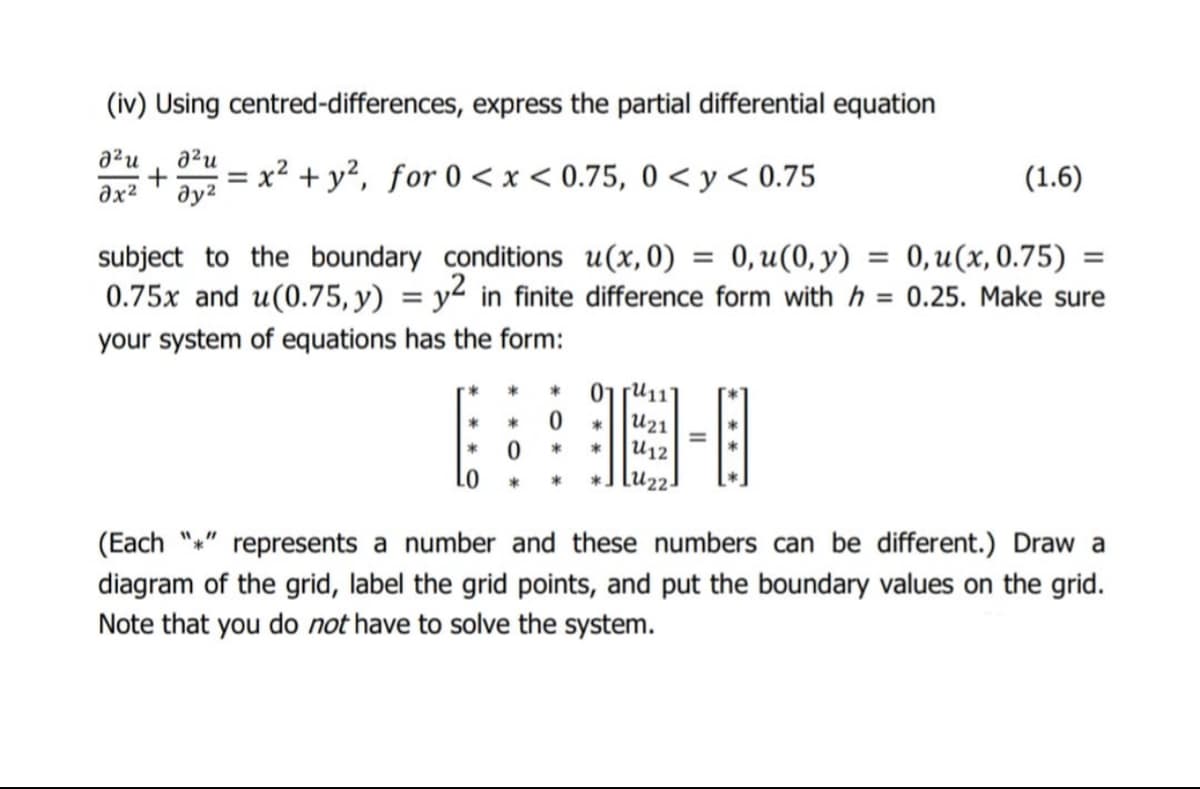(i) Consider the LU factorization 0 0 [b, C1 a2 b2 C2 0 0 a3 bz C3 as b, 14 0 0 01[1 u 0 0 01 U2 0 1 U3 1 (1.1) %3D 0 a3 l3 lo o 0 0 a, 4JL0 o 0 Work out the product on the right hand side to show that the result has the same non-zero structure as the left hand side. Hence, show that the elements ly and uu are given by the following formulae. l1 = b1, ui =7, 4+1 = b+1 - a¿+1U¡, i = 1,2,3. (1.2) %3D
(i) Consider the LU factorization 0 0 [b, C1 a2 b2 C2 0 0 a3 bz C3 as b, 14 0 0 01[1 u 0 0 01 U2 0 1 U3 1 (1.1) %3D 0 a3 l3 lo o 0 0 a, 4JL0 o 0 Work out the product on the right hand side to show that the result has the same non-zero structure as the left hand side. Hence, show that the elements ly and uu are given by the following formulae. l1 = b1, ui =7, 4+1 = b+1 - a¿+1U¡, i = 1,2,3. (1.2) %3D
Linear Algebra: A Modern Introduction
4th Edition
ISBN:9781285463247
Author:David Poole
Publisher:David Poole
Chapter3: Matrices
Section3.4: The Lu Factorization
Problem 34EQ
Related questions
Topic Video
Question
![Question 1 [25 marks]
(i) Consider the LU factorization
[b C1
0 0
0 0
0 a3
[1 u1
1
01
U2 0
1
a2 b2
C2 0
az l2
(1.1)
bz C3
0 0
0 az
lo o
Uz
1.
Work out the product on the right hand side to show that the result has the same
non-zero structure as the left hand side. Hence, show that the elements l, and uu
are given by the following formulae.
l1 = b1, uj =4, l+1 = bi+1– ai+1ui, i = 1,2,3.
(1.2)
(ii) Consider the differential equation
y"(x) = y(x)
(1.3)
with domain 0 <x< 2 and boundary values y(0) = 1, y(2) = 0.25. If we use the
central finite difference formula for the second derivative to discretise the differential
equation and take the step size to be h = 0.4, show the discretization results in
following system of equations:
图-L
[2.25
-1
0 0
1
2.25
-1 0
2.25
y2
-1
0 -1
0 0
(1.4)
-1
Уз
-1
2.25ly4
L0.0820850I
Use the formulas (1.2) to find the LU factorisation of the matrix in (1.4). Use 4
significant figures for your calculations.
Then, solve the system using LU factorization and show that
y1 = 0.609427,y2 = 0.371211, y3 = 0.225799, y4 = 0.136837.
(1.5)
(ii) Show that the exact solution to equation (1.3) which also satisfies the boundary
conditions y(0) and y(2) is given by y(x) = e-x. Use this result to determine the
discretization error in the numerical solution obtained in part (ii).
kel](/v2/_next/image?url=https%3A%2F%2Fcontent.bartleby.com%2Fqna-images%2Fquestion%2F9d9b2fdc-aca5-49e4-9c03-ab242757ddbb%2F61b100a2-c088-49ca-aeb2-bb36ce3e7e6f%2F3ymj5uw_processed.jpeg&w=3840&q=75)
Transcribed Image Text:Question 1 [25 marks]
(i) Consider the LU factorization
[b C1
0 0
0 0
0 a3
[1 u1
1
01
U2 0
1
a2 b2
C2 0
az l2
(1.1)
bz C3
0 0
0 az
lo o
Uz
1.
Work out the product on the right hand side to show that the result has the same
non-zero structure as the left hand side. Hence, show that the elements l, and uu
are given by the following formulae.
l1 = b1, uj =4, l+1 = bi+1– ai+1ui, i = 1,2,3.
(1.2)
(ii) Consider the differential equation
y"(x) = y(x)
(1.3)
with domain 0 <x< 2 and boundary values y(0) = 1, y(2) = 0.25. If we use the
central finite difference formula for the second derivative to discretise the differential
equation and take the step size to be h = 0.4, show the discretization results in
following system of equations:
图-L
[2.25
-1
0 0
1
2.25
-1 0
2.25
y2
-1
0 -1
0 0
(1.4)
-1
Уз
-1
2.25ly4
L0.0820850I
Use the formulas (1.2) to find the LU factorisation of the matrix in (1.4). Use 4
significant figures for your calculations.
Then, solve the system using LU factorization and show that
y1 = 0.609427,y2 = 0.371211, y3 = 0.225799, y4 = 0.136837.
(1.5)
(ii) Show that the exact solution to equation (1.3) which also satisfies the boundary
conditions y(0) and y(2) is given by y(x) = e-x. Use this result to determine the
discretization error in the numerical solution obtained in part (ii).
kel

Transcribed Image Text:(iv) Using centred-differences, express the partial differential equation
a'u
x² + y?, for 0 < x < 0.75, 0 < y < 0.75
(1.6)
ax2
ду?
0, u(0, y)
0, u(x, 0.75) =
subject to the boundary conditions u(x,0)
0.75x and u(0.75, y) = y² in finite difference form with h = 0.25. Make sure
%3D
%3D
your system of equations has the form:
01 ru11
U21
U12
(Each "*" represents a number and these numbers can be different.) Draw a
diagram of the grid, label the grid points, and put the boundary values on the grid.
Note that you do not have to solve the system.
Expert Solution
This question has been solved!
Explore an expertly crafted, step-by-step solution for a thorough understanding of key concepts.
Step by step
Solved in 2 steps with 10 images

Knowledge Booster
Learn more about
Need a deep-dive on the concept behind this application? Look no further. Learn more about this topic, advanced-math and related others by exploring similar questions and additional content below.Recommended textbooks for you

Linear Algebra: A Modern Introduction
Algebra
ISBN:
9781285463247
Author:
David Poole
Publisher:
Cengage Learning

Algebra & Trigonometry with Analytic Geometry
Algebra
ISBN:
9781133382119
Author:
Swokowski
Publisher:
Cengage

Linear Algebra: A Modern Introduction
Algebra
ISBN:
9781285463247
Author:
David Poole
Publisher:
Cengage Learning

Algebra & Trigonometry with Analytic Geometry
Algebra
ISBN:
9781133382119
Author:
Swokowski
Publisher:
Cengage